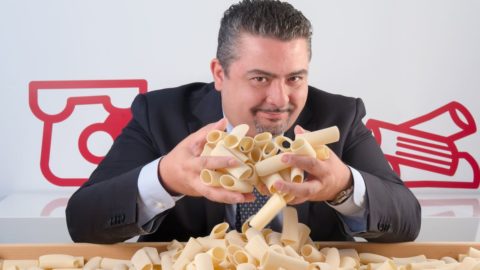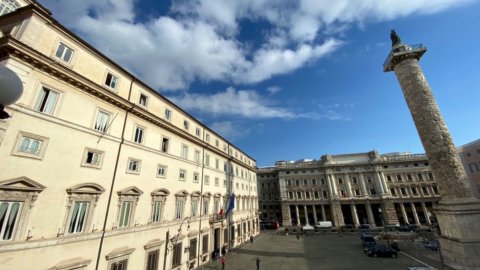He sits at the head of one of the giants of the Italian agri-food sector, the Di Martino group, pasta makers for three generations: 118 million Euros of consolidated turnover in 2017 (and growing strongly for 2018) 150.000 tons of product per year, 7 production plants, 395 employees, exports to 50 countries around the world (third group in Italy). Every day on five continents 10 million people eat his pasta. There's no denying it Giuseppe Di Martino, 48, who proudly bears the name of the company's founder grandfather, can look back satisfied, even if he doesn't like doing so much. In fact, one does not start from 6 million in turnover to reach 118, maintaining the family setting of the company, if one does not learn to look far, far ahead in planning strategic decisions and conquests of international markets having to keep up with the big industrial companies in the central north.
Curiosity, the desire to learn, to grow, to challenge and challenge each other are attitudes that Giuseppe Di Martino has always had in his blood, even as a child when his grandfather took him around the factory in the center of Gragnano making him touch and smell the pasta , making him eat it raw, taking it to the drying rooms, to test the various stages of drying. And he was already thinking about how he could make a pasta of his own once he grew up. The words with which his grandfather explained pasta to him fascinated him and those sensations have remained indelible making him exclaim years later: "The most precious moments are those in which we can dedicate ourselves to what we love. Like a good plate of pasta, which, prepared in respect of skilful balances that are the result of tradition, is a delicate harmony that amplifies sensations and even opens the heart a little. A subtle pleasure like that of a poem, but immediate and concrete”.
However, passion and desire for a challenge do not arise out of nowhere. Giuseppe had inherited these qualities from his grandfather, the man who had given birth to the family's industrial adventure, who certainly wasn't joking when it came to audacity and dedication to work. An adventure that for the Di Martino family starts, to tell the truth, with a stroke of luck. In 1912 grandfather Giuseppe, then an eighteen-year-old worker at the Cipolla Lauritano pasta factory in Gragnano, founded in 1850, showed off with the owner for his determination, his commitment, his attachment to work. He started working in the company as a child at the age of ten, but soon climbed all the steps to become "master of the art of short pasta" and then "impastatore", or general manager of the pasta factory. The owner of the company is elderly and has three daughters. She sets her sights on him and makes him an offer. The pasta factory must not die, and its three daughters are unfit to work in a harsh working environment like the pasta factory. “According to the father – explains Di Martino today – they were not adequate to be able to work inside the factory where there were more than 70 almost naked men because they had to work in hot and humid environments where the pasta was dried, go in and out dressed only in a burlap sack. At the beginning of the century it was not a very honorable thing for a woman to manage a company where there was a great coming and going of discrete men, so the owner guaranteed a loan to my grandfather who bought the company and paid for it over 20 years”.
And here begins the incredible adventure of the Di Martino family. After just three years, the pasta factory under the direction of grandfather Giuseppe is already starting up in large numbers. In 1915 it was the first Italian pasta to cross the Panama Canal to reach the millions of Italians who were expatriates in the United States and in the Americas between the end and the beginning of the century. Upon Giuseppe's death, his sons Valerio and Gaetano took over. In the meantime, Gragnano pasta has made itself appreciated throughout Europe and business is booming. But then there is a setback. The twentieth century was a difficult century for the city of pasta. The two World Wars caused the production of Gragnano pasta to enter a crisis which, in the post-war period, had to face competition from the large industrialized pasta factories of Northern Italy which had more capital. The 1980 earthquake then aggravated the situation and reduced the number of pasta factories to only 8 units. The Di Martinos are holding firm, theirs is a very united family, supportive in their choices, rooted in the territory and in the wake of tradition, animated by true dedication and an irrepressible passion for work and for the family business.
In 95 Giuseppe was approaching the age of military service. Like many young people of those years he studies how to avoid it: “It was a key moment in my life because after university with a degree in economics and commerce I didn't want to do military service because I found it a waste of time. I learned that if you worked overseas you could make it to the age of 27 and trigger the age limit leave and so I went to England to work for a trading company importing and distributing foodstuffs. A new horizon opened up for me: commercial sales, negotiation, promotion techniques, but above all, I mentally entered the typology of the English company, the Anglo-Saxon method of doing business, based on facts and numbers, on an ability to develop internal marketing to the product and above all on the fact that there must be a value chain around production”.
A real revolution for a company run until then according to family traditions. Giuseppe returns to Italy full of new ideas.
“After the 1980 earthquake we had made many investments within the company to renovate the plant but the funding promised by the government arrived after 25 years, so the company was very exposed. When I arrived from England we had a turnover of 12 billion lire but we had debts of 15 billion. We needed a boost: I revolutionized everything from a commercial point of view. I trusted my father Valerio and my uncle Gaetano, they understood that the world was changing and that having lived in England for two years I could bring something new. Let me be clear, it's not easy because in family businesses you have to conquer the space. I began to travel to trade fairs around the world, studying competition, raw materials, forms of packaging, how to change the approach to the market, optimizing resources, streamlining procedures, communication, and so on”.
Giuseppe began to travel the world without stopping to study the final recipient and the markets, he even happened to sleep in conditions of luck. “Sometimes I would go to my importer's office and ask to be allowed to work late. In reality it was an excuse, I stayed to sleep on an armchair to save money”. But the results of all this work were not slow in showing their effects. Since the end of 97 the company has been continuously expanding. “Above all thanks to foreign markets where 70 percent of our production goes. As I like to repeat, Gragnano is a province of Tokyo because for us going to Milan costs 2500 euros while going to Tokyo costs 800 dollars. This condition has always led us to look and seek our customers outside our country.
The company's production capacity at these rates quickly becomes saturated. In 2006, since a portion of the clientele did not expressly ask for Pasta di Gragnano, the Di Martinos built a very large factory in Pastorano north of Capua, today it is one of the largest and most modern pasta factories in Italy, fully automated, fa more than 5000 quintals of pasta a day. All intended for export.
But that wasn't enough. Among the suppliers of the Martino Group was the Antonio Amato Pastificio, a glorious past, with exports all over the world: to Europe, Japan, the Middle East, North and South America, Australia and New Zealand”. Pastificio Amato enters into crisis, layoffs, balance sheets in court and a tangle of civil and criminal requests. It's a risky bet. Di Martino looks far ahead, comes forward to take over the company. And at the end of 2012 even this gamble paid off, Pastificio Amato became part of the Di Martino group and returned to the market with the thirty main formats, distributed in 600 Italian, Australian, South African, Canadian, Californian, German and Kuwaiti stores .
But the real turning point towards a new culture of pasta has distant roots. In via dei campi in Gragnano, where Giuseppe and his sister Giovanna started a research center in 1998 to improve the quality of the product which then turns into an experimental pasta factory. “When we started with the Pastificio dei Campi – Giuseppe Di Martino recalls – I told my sister: in 1912 my grandfather bought the pasta factory. It's been a hundred years. What has been your and my contribution within the company since we've been working on it? I don't want that in a century, we will be remembered only as the heirs". The idea of flying high, of launching yet another challenge was already in the air. In fact, since 1999 the Pastificio dei Campi has been making only pasta from Italian durum wheat traced to the field and it was a great gamble. “In 2102, my research was essentially directed to the raw material in search of the flavors of the past that had now been lost. The capacity and production of Italian wheat was reduced by 30% every year precisely due to the competition from the Canadian American markets where large multinationals, large cooperatives and also large Italian industrial customers pushed because they wanted more stable markets in which large producers could plan production to the myriad of small Italian producers”.
Joseph glimpses in that great myriad of very small producers scattered between Campania, Molise and Puglia "which for me is the area most naturally devoted to making durum wheat, a wealth, because where there is biodiversity, there is wealth". Talking to the farmers he discovers that they used more than 250 varieties of wheat while big industry uses only 3 or 4. From there the great intuition comes. “We sat around a table and I said to them: how do you make the best wheat ever? We have to start from the earth. All the pasta factories talk about their pasta, none of the land. I proposed contractual program agreements to them, binding them for a period of six years, which would have greatly reduced the yield per hectare since one year we would have sown field beans, a leguminous plant rich in fixing nitrogen, on that land, one year we would have kept the land fallow , i.e. at rest, and only the following year would we sow wheat.”
Economically a foolhardy if not crazy idea, the company would have paid the farmers for all the lost earnings of an annual intensive sowing to have a harvest once every three years. “I encountered a lot of resistance also from the family: above all due to the high costs of the operation which would have been reflected in the cost of the product for which I also planned packaging suitable for its caliber. My answer was: since I pay him so much, if someone wants to follow me, he has to pay the same. I had conceived a transparency and quality policy that no one had ever thought of before". And the quality skyrockets, the slogan of the product obtained from that grain becomes without false modesty: "Pastificio dei Campi, the best pasta ever”. A pasta made with 100% Italian durum wheat semolina, with a protein content that exceeds 14%, bronze drawn. And, another great find, a pasta made with traced wheat: the consumer can follow all the steps of the supply chain simply by entering the name of the format and the product expiry code on the website www.pastificiodeicampi.it, and via Google Maps he can go directly to field and check where what he is eating is coming from.
In 2009 the first package was released, it was an immediate success. The great chefs request it and put the name of the pasta factory on the menus next to the dishes to underline the quality of the preparation: "They called me and told me, but this pasta tastes like wheat, it smells like wheat, consumers are starting to ask what grain do you use? An unthinkable question until then, it was what I had wanted, a return to the true flavors of the past, accepting as my own the watchwords "good, clean and fair" of Carlo Petrini, founder of slow food. Add to this another satisfaction: last year what was my project becomes a state law, Minister Martina promulgates a law that says every pasta must have the label of the origin of the wheat, it must indicate the country from which it comes and many altars have been discovered".
It should be enough ? Absolutely not, because the cultural revolution of pasta started with the Pastificio dei Campi is only just beginning. For Giuseppe Dio Martino it is not enough to have affirmed the importance of quality there is above all, today as today, the need to culturally train the consumer, so that the use of pasta is aware of its values which are not organoleptic and gustatory but also social and cultural.
And here is the birth, fruit of the experience gained in his travels around the world, of three projects that once again make us understand how this man, constantly restless when he talks about his work and his company – perhaps it is his grandfather's DNA Giuseppe who presses – always keep an eye on the horizon in search of new projects, lands to cover and spaces to conquer. They are called La Devozione, the Pasta Store; the Sea Front Pasta bar. Let's get ready to find them on our next trips abroad, because requests are arriving from all over the world. All are part of a new philosophy, the disintermediation. “The distribution chain – he observes – today is no longer current, indeed it is in crisis. The consumer has no faith in the markets, he is disoriented. Once when he went to the shops he found the shopkeeper who gave him advice, suggestions, on the products and on the combinations. Today everything has become anonymous. And then I began to open a series of points of sale with staff that we specially trained, specialized in providing answers, in resuming that dialogue of the past between seller and consumer that had been interrupted, explaining the various types of pasta, how to cook them , how to choose the best combinations”.
The first Pasta-store starts at Capodichino airport, 100 shapes of pasta on display, you'll be spoiled for choice, staff advice turns into a reasoned journey within the planet of pasta. Then it's the turn of the Bologna airport, then of a large space in Fico, then, an obligatory choice, it's the turn of Naples in Piazza Municipio, then it will be the turn of other 16 points of sale in international airports on three continents including Dubai, Singapore, Taipei, Tokyo, Shanghai, Beijing, Hong Kong, New York, San Francisco, Chicago, London, Paris, Munich, Amsterdam, real temples of pasta as Italian ambassador in the world.
In the central Piazza del Municipio in Naples, the three cultural guidelines of Pasta conjugated by Di Martino find their synthesis in a multifunctional space. Ground floor, "Devotion" it is a tribute to the quintessential Neapolitan style, spaghetti with tomato sauce. 125 grams of Spaghetti di Gragnano PGI produced with 100% Italian wheat, 400 grams of Corbarino tomato, extra virgin olive oil, a sprig of fresh basil and a clove of garlic are cooked. The final surprise? A slice of bread placed on the bottom of the container to make the slipper! All prepared expressly and on sight, in just 8 minutes, to show the preparation of Spaghetti to go in total transparency.
On the first floor, from appetizers to desserts, Di Martino IGP Gragnano pasta, produced with 100% Italian durum wheat semolina, bronze-drawn and slowly dried at low temperatures, is the true star of the Sea Front Pasta Bar in its over 120 formats, interpreted and experimented from time to time through the creativity of the resident chef Pierpaolo Giorgio.
18 seats arranged around a single counter that embraces the central kitchen, in an oriental way, from which you can peek at what's cooking, deliberately closer to the diners than to the chefs so that even physically the patrons participate in the process of making the dishes; but there is also a table de Chef for two overlooking the Maschio Angioino and the port of Naples; and 1 table for two dominates the splendid Piazza Municipio. In its dynamism, the restaurant offers spaces for a sophisticated or romantic dinner, but also spaces for a quick lunch, in company or even alone. A place that adapts to new international trends, but always looking to the Neapolitan tradition of sharing one's time with others, around a plate of pasta made as God wills. Going out on the ground floor you will find a well-stocked room Pasta bar with the 120 formats of Di Martino production, from those known to all to the most sought after and ancient ones, such as the "Originals" or the long formats wrapped by hand to remember and keep alive the historic Gragnano tradition of pasta makers. And then another touch of modernity and glamour, the brand new packages designed for the pasta factory by Dolce&Gabbana, which signs the look with a nod to the colors and symbols that make Italy and the Mediterranean world famous.
What to say? If you think that the surprises have ended in this field, you are in a big mistake. Because the journey towards the future of Di Martino pasta has only just begun.





